Six

Shropshire
www.english-heritage.org.uk/visit/places
/acton-burnell-castle
A thirteenth-century fortified manor house located in Shropshire, Acton Burnell Castle is a Grade I listed building. It is thought that the first Parliament of England where the Commons were fully represented was held here in 1283.
In 1284, Robert Burnell obtained a license to crenelate from the king although, given the large size of the first-floor windows of the castle, it would appear that it was designed to impress rather than have any serious defensive aspirations.
Abandoned by 1420, it was allowed to decay while a new house, Acton Burnell Hall was built next to it in the eighteenth century and all that remains today are the impressive ruins of the outer shell of the manor house and the gable ends of the barn.
The castle has long been rumored to be haunted by a girl in a white dress and in February 2004, student Stuart Edmunds and a group of friends visited Acton Burnell Castle after dark and came away with the impression that the ghost was very real. Edmunds was quoted as saying to the online BBC that:
As I walked towards a doorway in the darkness, there appeared to be the silhouette of a figure in the doorway. As I stood frozen on the spot my immediate explanation was that someone had seen our torch light and come to throw us off the grounds. But as I stood alone in silence, I heard a breath above the sound of my own breathing. To hear more clearly, I held my breath and to my astonishment the dark shadow moved toward me. Without thinking I took a photo in the direction
of the figure and saw in the flash light the misty
face of a young woman and a portion of her white lace dress floating upward. I managed to get this photo which shows a mist towards the wall and a distorted face.
Warwickshire
www.arburyestate.co.uk/index.php?page=astley-castle
Now a modern holiday home, Astley Castle was previously a ruined, fortified sixteenth-century manor house as well as a Grade II listed building and a Scheduled Ancient Monument. It belonged to the Astley family from the twelfth century but passed to the Greys in 1420 when Joan de Astley, wife of Reginald Grey, 3rd Baron Grey de Ruthyn, inherited the estate. It is believed that the Greys rebuilt the manor house around 1555. After the Greys were disgraced, it passed to the monarchy and later, during the English Civil War, it was garrisoned by Parliament. In the 1960s it became a hotel, but this was short lived and the building was severely damaged by fire in 1978. It is believed that Lady Jane Grey may haunt its rooms and corridors.
Henry Grey, Duke of Suffolk, was the father of Lady Jane Grey. He was beheaded on 23 February 1554 after being convicted of high treason for his part in Sir Thomas Wyatt’s attempt to overthrow Queen Mary after she announced her intention to marry Philip II of Spain. Henry’s headless ghost is also said to haunt the castle.
Interestingly, following the fire of 1978, Gef White, a journalist for the Tribune, wrote, “The mystery is intriguing investigators of the blaze. A room was exposed by the fire and detectives were shown a circle of black lace, horror masks and three ‘death ritual’ dolls, stabbed by nails coated in red paint. The room, tucked away in a top corner of the castle, contained three dolls. The faces of each were painted in a tragic grimace and nails pierced their hearts and legs. On the door of the room was a hand-painted symbol like a huge question mark.”
Maybe Astley Castle holds more secrets than we know.
Warwickshire
www.dudleyzoo.org.uk/dudley-castle
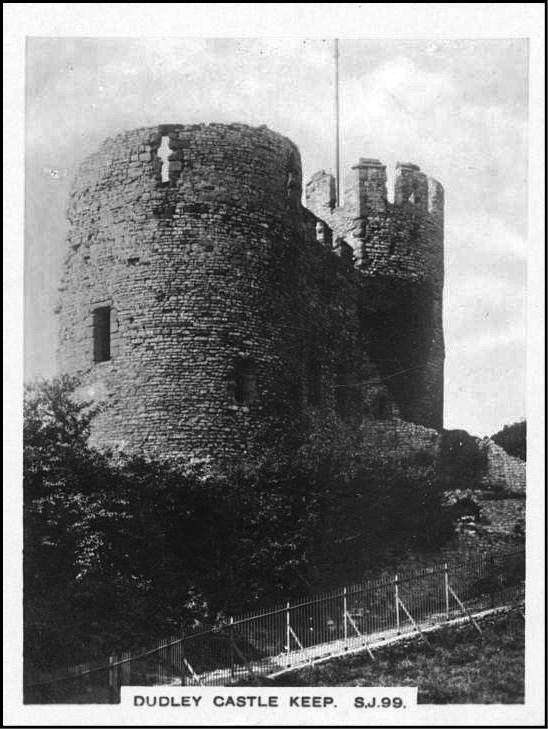
According to legend, a Saxon Lord by the name of Dud constructed a wooden castle on the site where Dudley Castle stands today. Although this claim is not taken seriously by historians, it is thought that Ansculf de Picquigny built the first structure, a wooden motte-and-bailey, in 1070 and that his son, William Fitz-Ansculf, was in possession of the castle when it was recorded in the Domesday Book of 1086.
During the English Civil War in the 1640s the castle was garrisoned by Royalist troops and was twice laid under siege, the first being in 1644. With the tide of war going against the Royalists, a Parliamentarian General, Sir William Brereton, advanced toward Dudley for the second siege after which Colonel Leveson, commander of the Royalist garrison, surrendered the castle on the 13th of May 1646.
As with most Royalist garrisons, the castle was destroyed, and all of its defenses demolished. The keep, gatehouse, and defensive walls were all ruined although the domestic buildings were surprisingly spared. However, in 1750 a fire swept through the remains and, as it was rumored that the local militia kept their gunpowder in the castle, nothing was done to put out the fire. Dudley Castle was reduced to a romantic ruin.
It is now regarded as one of the most haunted locations in the Midlands and perhaps the British Isles themselves. There are many spirits that have been reported here throughout hundreds of years, although the most famous of these is that of the Grey Lady, believed to be the spirit of Dorothy Beaumont who lived in the castle for a time and gave birth to a daughter there. Sadly, the daughter died during birth, and various complications led to Dorothy’s death soon after.
Dorothy apparently asked to be buried beside her daughter and expected that her husband would attend the funeral. However, neither of these happened and as a result, she continues to be tormented to this day and is said to wander aimlessly around the castle and its grounds.
Her ghost has often been seen near the castle keep as well as in the Grey Lady Tavern, a pub on the castle grounds that was named after her. Since opening, there have been reports of a strange blue mist that floats through the bar and is often accompanied by unexplained sounds. As well, the pub experiences alarms going off and extreme drops in temperature.
In August 2014 a couple, Dean and Amy Harper, managed to take a photograph of what appeared to be the famous Grey Lady and a young child in the door of Sharington Range, a set of buildings within the castle. Speaking to the Birmingham Mail, Dean Harper stated that “we went up to the castle ruins and while we were up there we thought we’d get some pictures of the grounds. On looking through the images that night, Amy saw a glow, as though a light was on on the top window level. On zooming in we noticed on the bottom, inside an arch, there was a lady and what appears to be a little girl, too.”
About a year after the photograph came to light, another shot was taken by Lee Machin, apparently capturing the image of a shadowy figure in virtually the same spot. Machin, who was visiting the zoo enclosed within the castle walls, was taking a photo of his nine-year-old nephew and, when later looking through the images, noticed a startling sight—an indistinct ghostly figure standing in an archway.
Another frequently seen ghost at the castle is that of a Civil War drummer boy. He was reputedly killed by a bullet from a musket and he’s been heard numerous times at night, tapping out various drum rolls as if in battle. Legend has it that it’s deemed bad luck to hear or see him.
Apart from this, the most haunted location in the castle is thought to be the chapel undercroft, and in one room there is a stone coffin that is believed to have held the body of John Somery, apparently one of the castle’s most feared lords. People have reported seeing disembodied legs beside the coffin while others have reported having their clothes tugged and their bodies prodded. Others have also reported strange grinding noises coming from the chapel above which, upon investigation, abruptly stop.
Herefordshire
www.english-heritage.org.uk/visit/places/goodrich-castle
Originally an earth-and-wooden fortification, probably built by Godric of Mappestone after the Norman invasion, Goodrich Castle was replaced with a stone keep in the middle of the twelfth century and was later expanded again during the late thirteenth century. It was the seat of the Talbot family before they fell out of favour in late Tudor times.
146
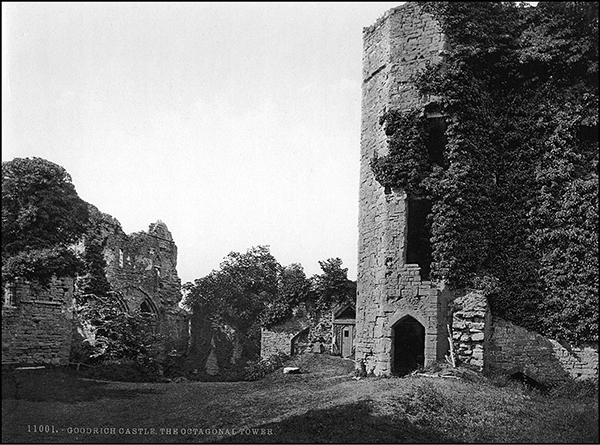
At the end of the eighteenth century it became a noted picturesque ruin and the subject of many paintings and poems, and even provided the inspiration for Wordsworth’s 1798 poem We are Seven. Today it is a pretty ruin standing on a wooded, rocky spur overlooking the tranquil waters of the River Wye and is open to the public.
It is said that during the English Civil War siege, Alice Birch, the niece of a Parliamentarian officer, took refuge in the castle with her Royalist lover, Charles Clifford, a young officer. When it became clear that the fortress could no longer stand up to the constant bombardment, Clifford and Birch mounted a horse and, under cover of darkness, rode from the castle, managing to break through the enemy lines.
Sadly, heavy rains had swollen the River Wye and its muddy banks were slippery and dangerous. Attempting to cross the raging waters the horse lost its footing and the two lovers were swept away to their untimely deaths. Their ghosts, mounted on horseback, have been seen in the grounds of the castle as well as struggling in the river. Passersby have also reported seeing the ghosts staring from the ruined ramparts late at night.
As well, the Great Keep, sometimes called the “Macbeth Tower,” is reputed to be haunted by the ghost of an Irish chieftain who was held prisoner there. Legend suggests that he died attempting to escape, which is why his ghost is said to still haunt the Tower
Shropshire
www.hoptoncastle.org.uk
Situated in Shropshire, Hopton Castle was probably founded in the twelfth century as a motte-and-bailey and later rebuilt in stone by Walter de Hopton during the Barons’ War of the 1260s. During the English Civil War it was owned by Sir Henry Wallop. He fortified it as a parliamentary stronghold at the outbreak of the war but died before he could take part in the conflict, leaving it to his son, Robert Wallop,
The castle was apparently still habitable in 1700 but fell into disrepair soon afterward although substantial remnants of the keep remain. In 2010 it featured in the British TV series Time Team and was officially reopened to the public as a visitor attraction in December 2011 by the Duke of Gloucester. Now a romantic ruin, it is reputed to be haunted by a group of Parliamentarian soldiers who met their untimely end in the icy waters of the castle moat.
During the Civil War, it was one of the few castles in the west to be held by Parliament. In 1644 Royalist troops numbering around five hundred laid siege to the castle which was defended by about thirty Roundheads under the command of Samuel More. More, overwhelmingly outnumbered, eventually agreed to surrender.
Accounts vary as to what happened after the surrender, however, the surrendered Parliamentarian troops were massacred and then thrown into the moat. As a result, the castle is said to be haunted by the ghosts of the murdered men as well as four Royalist soldiers who died in the fighting. The ghost of Elizabeth Mayrick, the widow of one of the men, is also said to haunt the castle, crying for her lost love.
Warwickshire
www.english-heritage.org.uk/visit/places/kenilworth-castle
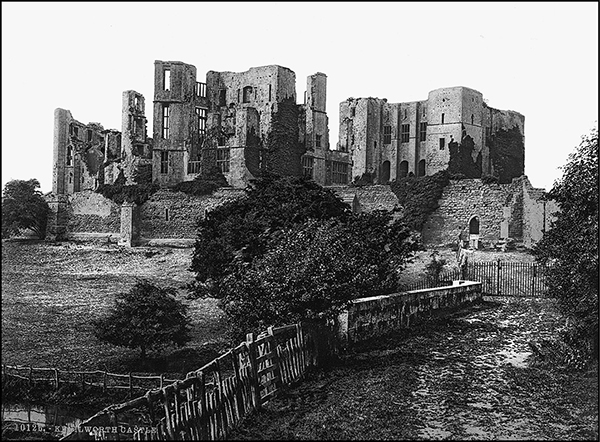
Built over several centuries and founded in the 1120s around a commanding Norman tower constructed by Geoffrey de Clinton, Kenilworth Castle was significantly renovated and enlarged by King John at the beginning of the thirteenth century, turning it into one of Britain’s most impressive castles.
In 1266, the castle was the subject to the six-month long Siege of Kenilworth, which is believed to have been the longest siege in English history and formed the base for Lancastrian operations during the Wars of the Roses. As well, it was also the scene of the removal of Edward II from the English throne and the French insult to Henry V in 1414.
John of Gaunt, son of Edward III, spent lavishly and eventually developed the castle into a palace, constructing the great hall and associated rooms. In 1563, Elizabeth I bestowed the palace to Robert Dudley, the Earl of Leicester.
In 1649, the castle was partly destroyed by Parliamentary forces to ensure that it could no longer be used as a Royalist stronghold, and during the eighteenth century it became somewhat of a tourist destination and these days is managed by English Heritage.
It is a Grade I listed building and as a Scheduled Monument, it is open to the public.
It is said that it is haunted by a number of ghosts from different periods in the castle’s history, including a man dressed in black who was killed in a sword fight at the castle gatehouse and a ghostly boy who has been regularly seen in the castle stables, surprisingly, along with ghostly horses and chickens.
Apart from this, the gatehouse is said to be haunted by the spirit of an old woman and a little girl who is said to appear to visitors and ask them where her father is.
Shropshire
www.ludlowcastle.com
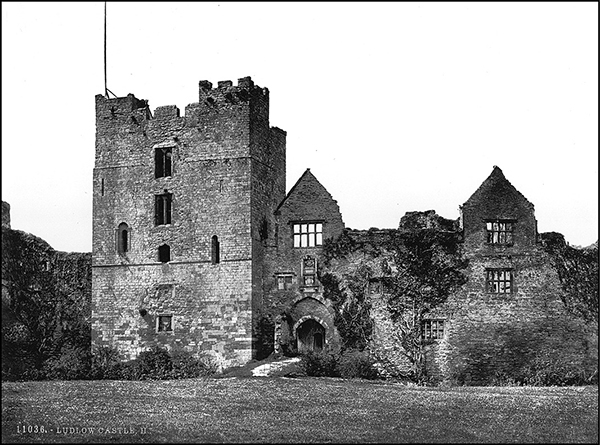
Ludlow Castle is a now-ruined medieval fortress sitting on a rocky outcrop overlooking the River Teme. It was probably founded by Walter de Lacy after the Norman Conquest and was one of the first stone castles to be built in England, consisting of a rectangular outer bailey and an oval inner bailey entered through a gatehouse called the Great Tower which was installed during the Civil War when the castle changed hands several times. Sadly, after the Civil War, the castle became neglected and quickly fell into ruin.
The castle is reputed to be haunted by Marion de la Bruere who, roughly nine hundred years ago, had a secret lover called Arnold de Lys who got into the castle by a rope that Marion lowered over the battlements. However, one night de Lys betrayed her by leaving the rope available to his soldiers who then entered the castle and began killing the occupants. Realizing that she had been tricked, the despairing Marion leapt out of bed, grabbed de Lys’ sword and killed him after which she leapt to her death from the top of the Pendover Tower, also known as the hanging tower.
It has been reported that Marion’s ghost can sometimes be seen at dusk wandering around the base of the tower itself and that her screams can be heard on the anniversary of her death. The Hanging Tower is also supposed to be haunted by the sound of heavy breathing, attributed to a ghostly soldier, while many visitors and staff have reported hearing voices from empty rooms as if someone is having a conversation.
Staffordshire
www.tamworthcastle.co.uk
A Grade I listed building, Tamworth Castle is a Norman castle located in Staffordshire. Overlooking the River Tame, the site has been inhabited since Anglo-Saxon times, and today it is one of the best-preserved Norman motte-and-bailey castles in England.
153
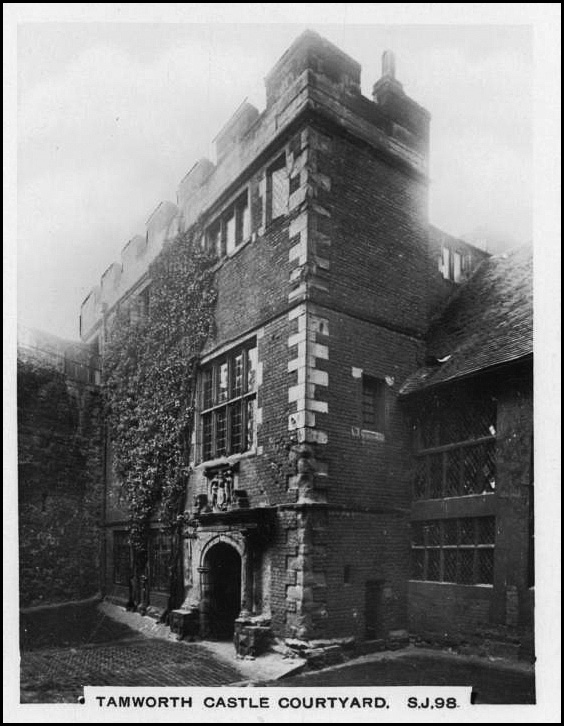
Built mainly in the late twelfth century, the castle was first constructed in 913 AD by Alfred the Great’s daughter then later, William the Conqueror, who gave the land to Robert De Marmion who built the keep and curtain walls that stand to this very day. Unlike many castles however, it somehow escaped being destroyed by Oliver Cromwell during the English Civil War.
It is, of course, rumored to be haunted by a number of spirits, so much so that the middle chamber of the Norman tower is called ‘the ghost room’ for fairly obvious reasons given that the apparition of the “Black Lady of Tamworth” has been sighted on numerous occasions. The Black Lady is allegedly the ghost of a nun named Editha who founded an order in the ninth century and who were ejected from their convent by Robert de Marmion. Despairing for their future the nuns prayed to their founder and, as legend has it, she appeared at a banquet one night and attacked Marmion, warning him that unless the nuns could return to their convent, he would succumb to a terrible and painful death. She then struck him on the side with the point of her crosier, and the wound from the blow was so terrible that Marmion’s agonising cries awoke the whole castle. The pain only ceased when he vowed to allow the nuns to return.
Apart from the Black Lady of Tamworth and her interesting, if slightly unbelievable, exploits from the grave, many have claimed to have seen another apparition, this time known as the White Lady. She is said to have been kidnapped and imprisoned in the tower by an evil knight by the name of Sir Tarquin, and despite his evil intents, she fell in love with him until, one day, Sir Lancelot du Lac decided to rescue her, slaying Tarquin in the process. The White Lady was so distraught that she threw herself from the battlements, and her ghost is now seen walking the battlements and crying mournfully.
Other ghostly encounters at the castle include a member of staff who was working in the Tamworth Story room when she felt as if someone had thrown sand into her eyes. At the very moment she felt this, a colleague reported seeing a blue mist swirl around the room. A visitor to the castle also reported an almost identical experience just outside a room known as the Haunted Bedroom. He reported that it felt as though somebody had thrown something in his eyes.
In another inexplicable encounter a member of staff was alone in the castle one night waiting in the reception area while a technician was outside checking the alarm system. She heard footsteps and furniture being moved about the room above her and, knowing that no one was in the room, fled outside where she met the alarm technician. When she explained what had happened he told her that he had seen a strange figure looking down at him from one of the windows.
Staffordshire
www.tutburycastle.com
Now largely ruined, Tutbury Castle in Staffordshire has stood since at least 1071 and was a popular destination for royalty. It was also the home of John of Gaunt, Second Duke of Lancaster, whose descendants included Henry IV, his son, Henry V, and his great grandson, Henry VI.
Over time the castle suffered from numerous sieges which resulted in the castle needing to be rebuilt, however, in 1647 Parliament ordered the castle to be destroyed after backing Charles I during the Civil War. By sheer good fortune, however, the castle wasn’t completely destroyed, and the remains are now an elegant and picturesque ruin.
Importantly, Tutbury Castle is where Mary Queen of Scots was held captive on four separate occasions. And, as with many castles, ghosts are not unexpected visitors as it is believed to be haunted by Mary Queen of Scots, an apparition in a full suit of armor, a White Lady, a little boy, and a small girl.
Obviously the most famous of all these ghosts is Mary Queen of Scots. In 2004 she was witnessed standing at the top of the South Tower dressed in a full white Elizabethan gown peering down on a large group of visitors, apparently numbering upward of forty. When the group saw her, they thought it was a staff member and an elaborate ruse. However, it was later pointed out that no one on staff had a white gown and that they wouldn’t have been in the tower anyway. Importantly, with this sighting, is that the whole group witnessed the phenomenon at the same time.
As well, people leaving the castle in their cars have reported seeing a figure dressed in black looking through the window of the Great Hall. This is also believed to be Mary, and one summer she was seen by several senior staff members who are generally reluctant to talk about anything supernatural. Apart from that, a team of archaeologists who were taking part in a dig at the castle, witnessed her as well.
As important an historical figure as Mary is, she is not the only ghostly figure that lurks within the ancient ruined walls as the ghostly figure of a man in a full suit of armor has been seen numerous times. He has been seen outside of John of Gaunt’s Gateway, and on one occasion reportedly shouted, “Get thee hence!” He was last seen recently during the day by a visitor who reported hearing him say, “get over the fence,” although there were no re-enactments scheduled for that day. Interestingly, one could surmise that the latter phrase was simply a misinterpretation of the former.
Recently, eerie footage of a shadowy figure standing motionless against a wall for almost twenty seconds before steadily moving across the room and out of sight was captured by a TV crew while filming at the castle. Minutes before the footage was taken, the crew had to stop filming because of a series of taps, footsteps, and bangs that came from apparently nowhere. Bex Palmer, codirector of The Past Hunters, then spotted the figure, noting; “It was so scary. I am quite tough on investigations, but I was terrified because it seemed as though it was coming towards us.”
The figure, which has been previously reported, is said to be a man in a suit of armor known for shouting at guests and is locally known as “The Keeper.”
Apart from the frightening knight and Mary Queen of Scots, a white human-shaped mist is often seen on the grassy bank around the North Tower, and a little boy wearing a white shirt has been seen sitting on the stairs of the great hall. He is so lifelike that many visitors assume he is real boy. The ghost of a girl called Ellie has often been sensed in the king’s bedroom with visitors reporting her pulling fingers, holding hands, removing rings and causing an electric pulse in the arm.
In addition, film & TV crews often report batteries suddenly draining in their cameras and equipment. Strange blue lights have been witnessed moving around some of the rooms and at times they have been witnessed circling around people.
Warwickshire
www.warwick-castle.com
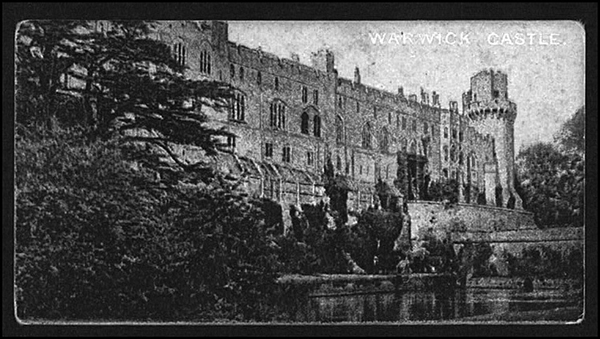
Originally a wooden motte-and-bailey castle constructed on a bend of the River Avon, Warwick Castle was rebuilt in stone during the twelfth century and was used as a fortification until the early seventeenth century when Sir Fulke Greville converted it to a country house. The castle was taken in 1153 by Henry of Anjou, later King Henry II and later besieged in 1642 during the English Civil War. However, it survived and today is one of the most well-preserved medieval castles in England.
It is protected as a Scheduled Ancient Monument and a Grade I listed building and now operates as a major tourist attraction including spectacular landscaped grounds designed by Capability Brown. From the top of the ramparts and towers, the visitor can experience breath taking views of the English countryside. However, this does not really concern us as, like most of these impressive structures, Warwick Castle is haunted.
Warwick Castle is well known for its ghosts, with many guests and visitors to the castle seeing apparitions and shadows that they cannot explain. In 1628, Sir Fulke Greville was stabbed by one of his servants when the servant discovered that he would not benefit from Greville’s will. After the deed, and horrified at his own actions, the servant cut his own throat and left Greville to die a very slow and painful death in the South Tower. It apparently took Greville a month to die, his anguish and pain compounded by the surgeon’s insistence on packing the wound with mutton fat. Many visitors have reported hearing his moans for help. Witnesses have also reported catching fleeting glimpses of his sad shape haunting the Watergate Tower, or, the ghost tower, as it is ominously known.
In the dungeon, growls are often heard, and people have encountered a malevolent spirit, said to be an elementary who manifests into an aggressive human form, while elsewhere extreme fluctuations in temperature, light anomalies and physical sensations of being pushed and grabbed are all commonly reported.
One of the more famous ghosts of Warwick Castle is that of a large black dog with red eyes and foaming mouth. This devil-dog is believed to be the result of a curse placed on the castle by a servant by the name of Moll Bloxham. She was caught stealing from the Earl and was publically tortured and shamed for her deeds. Not long after, it is said that the dog appeared and started to cause havoc within the castle grounds.
In 2009 the Birmingham Mail reported that work on a new tourist attraction at the castle was halted after builders working on the new dungeon attraction claimed to be subject to ghostly encounters. The exhibition, which included a torture chamber, would have actors dressing up as ghosts and creatures from the dead to create a spooky atmosphere for visitors. However, site manager Paul Woodfield was left terrified when he spotted a strange figure in the hallways at the site. He was so scared he immediately dropped his tools and ran away in fear. “When we started clearing out the site for the new dungeon, which is in what used to be the castle’s armory, I started to notice some pretty strange things. I kept smelling lavender which, for a building site, was very odd indeed. Later that day I saw a tall, slim man wearing some kind of tunic and trousers walking out toward the doorway.”
At the time, two mediums who visited the castle reported seeing a woman hovering around one of the doorways in the new dungeon area. They later suggested that the woman could have been the ghost of Frances ‘Daisy’ Greville, the Countess of Warwick and mistress to King Edward VII. They also noted a “general sense of fear and negative atmosphere”.
As recently as 2016, Mariehanna Dickson took a photograph in the castle’s Kenilworth room, a place reputed to be haunted by the ghost of a little girl. In the shot a small figure appears to be standing next to the window, but Dickson was completely alone at the time and later stated that she “was all alone in the room because it was early and there weren’t many visitors around. When I got home I was reading the plaque on my camera and noticed a strange figure in the reflection of the shot. At first I thought it must have been one of the wax work figures in the castle, but when I called them they said there were no models in that room. I was so intrigued I called them to ask if anyone else could have been in the room without my knowledge, but they said they checked the CCTV and it showed me taking the picture in a completely empty room.”
Shropshire
www.whittingtoncastle.co.uk
Whittington Castle in northern Shropshire was originally a motte-and-bailey castle, but this was replaced in the thirteenth century by a more substantial structure. Strikingly picturesque and romantic, it was a place of bitter border warfare, romance and legend. During the Civil War it was a Royalist stronghold until taken in 1643 by Cromwell’s Roundheads and over the years it has seen many changes. As a result, it is a favorite for paranormal investigators and ghost hunters alike.
Ghostly sightings at the castle include a hooded figure under the castle gateway, a phantom blacksmith in a worn leather apron, and the faces of ghostly children, which are spookily seen peering out of an upstairs window. Legend has it they died when a cursed Elizabethan chest was opened and the curse released. There is also a guard room that some staff members refuse to enter.
Sue Ellis, manager of the castle, thinks there may be a more grounded explanation to this fear than ghosts. She says, “It is interesting what happens, but sometimes you wonder if it’s because people are sitting in the dark. I think sometimes that creates a bit of apprehension and perhaps you start seeing things because your eyes aren’t used to being in the pitch black. It does get very, very dark in the guard room, and so that’s a bit scary in itself.”
Having said this, even Ellis admits and there are things that simply cannot be explained including a vigil that once was held in the court room which, unknown to most, was once an ironing room. She explained that “We did a planchette, which is where you put a pencil in a block of wood and see if it draws anything. When it had finished, it did look like an old iron, but then the sceptic in me says maybe if the pencil was swinging it would just draw a triangle, and it could have just been a triangle.
In addition she noted:
We had a photo taken during one of our vigils that shows a spirit person in the corner of our bookshop. There’s no room for a person to get into that corner, and I was in the room a minute after the picture was taken and there was no one there. Then we’ve had noises and a strange incident where there were a lot of children and we were playing with a ball in the old schoolroom and it was coming back to the same person each time, as though the floor was sloping. There was no real explanation.